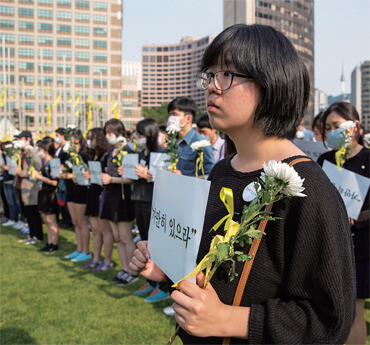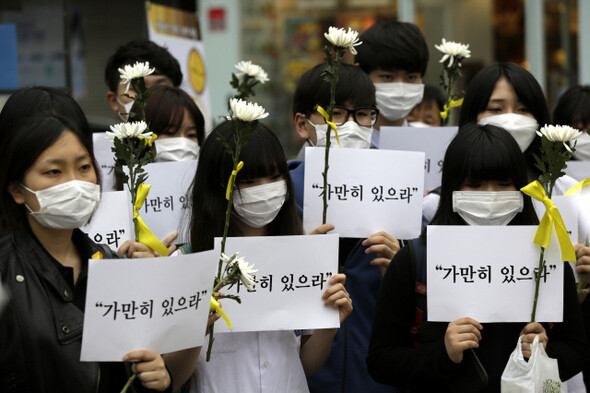hankyoreh
Links to other country sites 다른 나라 사이트 링크
[Year end series part I] One young woman who refused to stay where she was

This has been an eventful year. Countless precious lives were lost and bizarre scandals and incidents occurred one after the other. In our rage - and sadness - we are surprised to find how quickly time has passed. While we were mourning for the departed, there were sure to be stories that we missed - some of them stories that we really should not have missed.
In this series, Hankyoreh 21 weekly magazine looks back on 2014 through the lens of some of the cover stories that we ran this year. We will bring readers up to date on how these ten stories have developed since we first brought them to public attention.
“Stay where you are.”
On Apr. 30, clusters of young people with masks covering their faces filled the streets in Myeongdong, around Hongik University, and in front of Seoul City Hall. Their faces were young; in one hand the held a chrysanthemum, in the other, a placard.
Teenagers had died because adults had told them to stay where they were.
A petite female university student came to the microphone.
“More than 100 people are still down there in the cold water. I want to ask whether we are supposed to stay where we are like the captain and crew of the Sewol ferry told the teenagers onboard, like we are taught at school and in our society.”
This was Yong Hye-in, 24, the first person to propose holding a silent vigil to commemorate the victims of the Sewol tragedy.
Until the Sewol sank off the coast of Jindo, South Jeolla Province with 476 passengers aboard, Yong was about to graduate from university and was studying for the public service exam.

On Apr. 16, she was, like everyone else, infuriated at the sacrifice of so many young lives. But the blow fell especially hard on Yong. She had grown up in Ansan, Gyeonggi Province, where many of the victims had gone to school, and some of the victims had been her family‘s neighbors and friends.
“I had been trying to find a way to get by on my own, but I came to realize that it was more important to find a way to get along with others,” Yong told a Hankyoreh reporter in Sinchon, Seoul, on Dec. 16.
After the silent protest, Yong has continued to play an active role in efforts to fully investigate the causes of the Sewol disaster. She has taken part in all of the Sewol rallies, without missing a single one.
Since September, she has been responsible for organizing meetings between the families of the Sewol victims and university students. In September alone, more than 30 such meetings were held.
There was no way the government would leave Yong alone.
Yong has been officially charged with violating the Assembly and Demonstration Act by marching toward the Blue House during a demonstration for the Sewol victims. The demonstration took place on Oct. 31, when the ruling and opposition parties reached an agreement about the three Sewol bills (the special Sewol Law, the Government Organization Act, and the Yoo Byung-eun Act).
All of the participants in the demonstration except for Yong were summarily indicted, with the prosecutors asking for a fine of 500,000 won (US$453.23). Investigators branded the young people, who had been brought together through social media, as the Sewol Commemorative Youth Meeting.
On Nov. 26, Yong participated in her first trial. “The government has started to shower young people with fines. As soon as the special Sewol Law was passed, trials began for crimes committed during the demonstrations. I really think that the government thought it could satisfy the people’s desire to know the truth about the Sewol by passing the special Sewol Law,” she said.
Throughout this year, Yong has spent all of her energy on the Sewol tragedy. On the verge of graduating, she took a leave of absence from her university.
Yong’s plans for the future have changed as well. She was not working for a civic group and she was not related to any of the victims of the accident, but hardly anyone participated in the demonstrations as much as she.
“For me, the Sewol sharply delineates everything that came before and after. No doubt other people feel the same way, but the tragedy made me think that, if we let society keep going in this direction, this kind of accident could happen to me. I could be the victim, the culprit, or the bystander,” Yong said.
“I had been planning to choose the easy path of becoming a public servant, but I’ve learned that there are more important things than that. I guess I can’t become a public servant anyway now, with a criminal record and all,” she added with a laugh.
Now that the furor over the Sewol has faded after the National Assembly passed the special Sewol Law, Yong hopes to finally have a chance to rest and recover.
“There’s hardly anything for me to do right now. I’m in a bit of a quandary since I’m supposed to go back to school next semester. When the fact-finding commission is launched next year, citizens will have to monitor its activities. We need to come together once more,” she said.
Yong is a young woman who refused to stay where she was, a woman who put her words into action. She brought a glimmer of hope to South Korean society following the Sewol tragedy.

Please direct questions or comments to [english@hani.co.kr]
http://h21.hani.co.kr/arti/society/society_general/38641.html
The May 5, 2014 edition of Hankyoreh 21 weekly magazine
Editorial・opinion
![[Editorial] Does Yoon think the Korean public is wrong? [Editorial] Does Yoon think the Korean public is wrong?](https://flexible.img.hani.co.kr/flexible/normal/500/300/imgdb/original/2024/0417/8517133419684774.jpg) [Editorial] Does Yoon think the Korean public is wrong?
[Editorial] Does Yoon think the Korean public is wrong?![[Editorial] As it bolsters its alliance with US, Japan must be accountable for past [Editorial] As it bolsters its alliance with US, Japan must be accountable for past](https://flexible.img.hani.co.kr/flexible/normal/500/300/imgdb/original/2024/0417/6817133413968321.jpg) [Editorial] As it bolsters its alliance with US, Japan must be accountable for past
[Editorial] As it bolsters its alliance with US, Japan must be accountable for past- [Guest essay] Amending the Constitution is Yoon’s key to leaving office in public’s good graces
- [Editorial] 10 years on, lessons of Sewol tragedy must never be forgotten
- [Column] A death blow to Korea’s prosecutor politics
- [Correspondent’s column] The US and the end of Japanese pacifism
- [Guest essay] How Korea turned its trainee doctors into monsters
- [Guest essay] As someone who helped forge Seoul-Moscow ties, their status today troubles me
- [Editorial] Koreans sent a loud and clear message to Yoon
- [Column] In Korea’s midterm elections, it’s time for accountability
Most viewed articles
- 1[Column] The clock is ticking for Korea’s first lady
- 2Samsung barricades office as unionized workers strike for better conditions
- 3[Editorial] When the choice is kids or career, Korea will never overcome birth rate woes
- 4[Editorial] As it bolsters its alliance with US, Japan must be accountable for past
- 5S. Korea, Japan reaffirm commitment to strengthening trilateral ties with US
- 6[Guest essay] How Korea turned its trainee doctors into monsters
- 7Japan officially says compensation of Korean forced laborers isn’t its responsibility
- 8Why Israel isn’t hitting Iran with immediate retaliation
- 9Worse than worst case: Korea’s population is shrinking faster than predicted
- 10[News analysis] After elections, prosecutorial reform will likely make legislative agenda